Use the following link to download the August 17, 2024 issue of the syəcəb
Drive-in fun and fundraising

By Wade Sheldon, Tulalip News
On Saturday, August 10, hundreds of community members gathered at the Boom City lot behind the Tulalip Resort Casino to support the Cystic Fibrosis (CF) Foundation. The event, hosted by Dan and Kelsey Pablo, was the annual drive-in movie fundraiser for their son Keldon. It aimed to raise money and awareness for people suffering from cystic fibrosis. This year’s featured movie was Kung Fu Panda 4, and the event successfully raised $26,744 for the cause.

In addition to the movie screening, Kelsey and Dan organized a raffle with prizes donated by various businesses and local artists. The raffle items included hotel stays in downtown Seattle and Tulalip, Mariner’s memorabilia and game tickets, traditional wool skirts, and more.
Various local food trucks and vendors added to the festivities, offering delicious treats like homemade lemonade, snow cones, frybread, and tacos. Attendees enjoyed indulging in the tasty offerings. One of the kids at the event, Tyler, remarked, “This is fun. I liked the red raspberry lemonade I got.”

Kelsey explained the history and adaptation of the event. “This is year 16 of a Tulalip Cystic Fibrosis event, but our third year doing a drive-in. For fourteen years, we did a walk at the Amphitheater. Then, when COVID hit, because cystic fibrosis is a lung disease, we couldn’t have everyone close, so we came up with the drive-in movie so people could stay in their cars and stay separated. It was like bringing back the Thunderbird.”
Fondly recalling his high school memories of the Thunderbird drive-in, Dan shared, “It was always a fun time with friends.”

Highlighting the family and community involvement, Kelsey noted how amazing it is to see the money raised and awareness spread. She emphasized that everything is 100 percent donated, with contributions from friends, family, and the community. The raffle constitutes 90 percent of their fundraising since the event is free, aside from sponsorships from the Tribe and a few small businesses.
Dan expressed gratitude, saying, “We would like to thank the Tribe for all the help they have given. They let us use this place, and throughout the year, they help immensely with medical coverage for our son.”

Kelsey concluded, “We are truly grateful. There are a lot of CF families that struggle with supplies and medications, and this event will help with that.”
The evening was filled with laughter, camaraderie, and a shared mission. The event’s success highlighted the power of collective support in making a difference for those affected by cystic fibrosis.
If you or someone you know is impacted by cystic fibrosis and would like to make a difference by donating or learning more, please consider visiting fightcf.cff.org.
RaeVolutionary Buckets
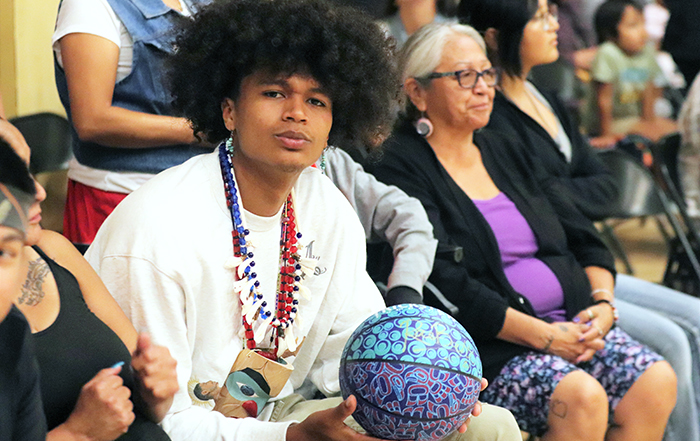
By Micheal Rios
The RaeVolution that is RaeQuan Battle’s evolution from a rez kid with a basketball to a professional bucket getter was celebrated in the traditional Tulalip way on Tuesday, August 13. A meaningful, community-led event to celebrate RaeQuan and his most recent basketball accomplishment – signing an Exhibit 10 contract with the Charlotte Hornets – was organized in the days following a breaking story by The Charlotte Observer. It’s just the latest development in the lifelong pursuit of Tulalip’s favorite baller as he lives out his hoop dreams.
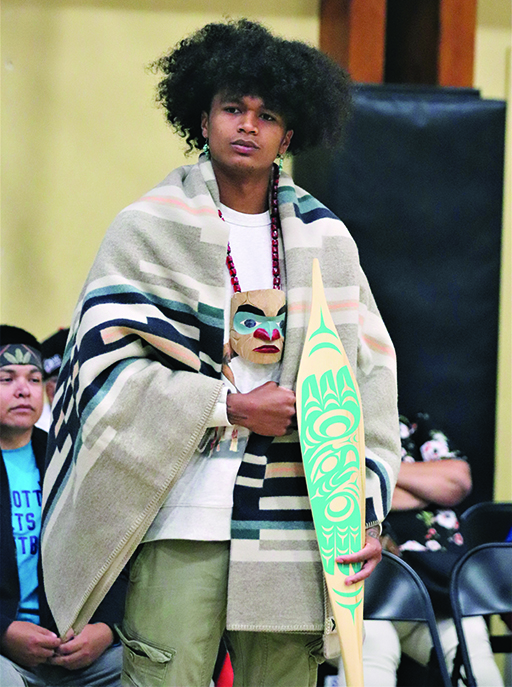
Let’s clear up the confusion around what exactly an Exhibit 10 contract is. In the simplest of forms, it’s a training camp contract. It allows for RaeQuan to continue to build off his NBA Summer League momentum, dawn the Hornets’ signature teal and purple colors, and gain further exposure training with and playing under the tutelage of an actual NBA team. The structure of the contract offers the Tulalip icon a chance to make an NBA roster during training camp or to stay within Charlotte’s development system through the G League.
According to Alex Kirschenbaum of Hoops Rumors, “[RaeQuan] could also see his training camp contract converted to a two-way deal with the Hornets up until the day before the regular season begins (October 22). Charlotte currently has one open two-way slot available, with the other two committed to point guard K.J. Simpson and center Moussa Diabate. It’s more probable that [he] will be cut prior to the start of the year and will then become an affiliate player with their G League Squad, the Greensboro Swarm.”
So essentially, in RaeQuan’s case, the signing of an Exhibit 10 contract with the Charlotte Hornets means that while he wasn’t drafted, he still has an opportunity to compete for a spot on the team. If he doesn’t make the final Hornets’ roster, the contract could be converted to a two-way deal, or he could join Charlotte’s G League affiliate. His community supporters will have to wait until October when the ’24-’25 NBA season begins for confirmation on his NBA status.
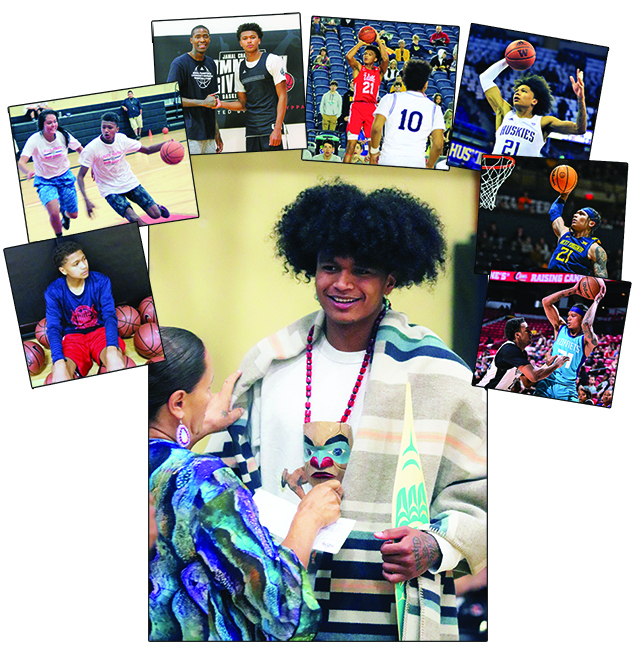
Alas, that’s over two months from now. Let us refocus on the present and the hundreds of Coast Salish tribal members, of all ages, who journeyed to the Youth Center on short notice to celebrate the 23-year-old hoops legend before he returned to Charlotte.
“This is something we needed to do because he deserves all the love and medicine we as a community can wrap him in. It’s like we always say, ‘If one of us makes it, then we all make it,’” explained grass-roots organizer Sara Hart. “I had support from Kim Kalliber who made the flyer, Jessica Bustad with getting this facility to host, and Chuckie Jones with organizing the coastal jam. I didn’t know what the turn out would be with only a few days to make this happen, but seeing the gym full now makes my heart so happy. Our community really came through.”
Kicking-off the cultural get-together, RaeQuan was blanketed by sisters Theresa and Shawnee Sheldon before being gifted a hand carved spirit mask necklace and custom paddle created by artist Ty Juvinel.
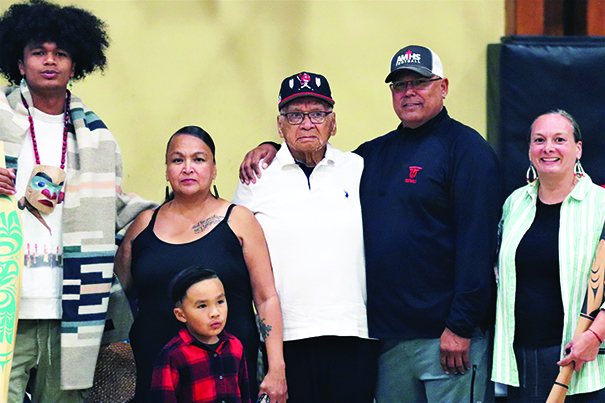
The 6-foot-5-inch RaeQuan was impossible to miss throughout the coastal jam that went well into the evening hours. He was either front and center with his mom and grandfather Hank Williams taking in all the glorious spiritual energy, on the court dancing with his fellow culture bearers, or, as was often the case, basking in community fandom by taking photos and signing autographs.
Youth, adults, and elders alike beamed with pride as they stood in the presence of the Tulalip trailblazer of the hardwood. RaeQuan was gracious enough to autograph any items they presented to him and didn’t say no to a single photo request. This seemingly simple act was not lost on Marlin Fryberg, who has known RaeQuan since before he could dribble a basketball.
“He definitely has the heart to give back to his community, supporters throughout Indian Country and the kids who idolize him. His desire and willingness to give back is an often-overlooked part of his story,” said Marlin. “He’s had challenges, some big, some small, but every challenge he’s managed to rise to the occasion. The whole community is proud of him. We hope he maintains this trajectory to reach heights none of us have seen before. He has a lot of work still to do, but he enters this next stage of his journey knowing he has the support of his Tribe every step of the way.
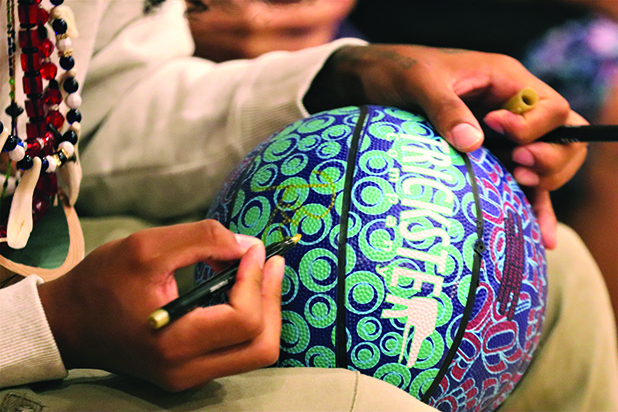
Tulalip Boys & Girls Club. Marysville Pilchuck High School. The University of Washington. Montana State University. West Virginia University. NBA Summer League. All of these are stages of RaeQuan’s basketball journey. As he’s journeyed through the world of basketball, he’s illustrated determination, adaptation, resiliency, and cultural pride.
He never shies away from telling people where he’s from and who he is as a proud Tulalip tribal member. That intention to never forgetting his roots, instead to showcase them whenever possible, is a big reason why so many from throughout Coast Salish territory showed up to shower him with all the positive vibes.
“This means the world to me that people not just from our reservation but other reservations and Canada, too, came together to sing and drum and really send me off on this next journey in the best possible way,” shared RaeQuan. “Tulalip and the game of basketball have been my whole world. For them to come together in this way, at this moment is just surreal to me.
“Everywhere I go and everyone I meet, I try to represent the Tribe in the best way that I can,” he continued. “I wouldn’t be here today with the opportunity I have before me if it wasn’t for my mom, my grandparents, and all the coaches and community supporters who have been courteous enough to help me along the way. All this support gives me the strength to kick down the door of the professional world.”
Breaking down barriers and getting buckets. In true RaeVolution style.
Protect Act 2024 aims to help tribal courts and law enforcement combat the opioid epidemic
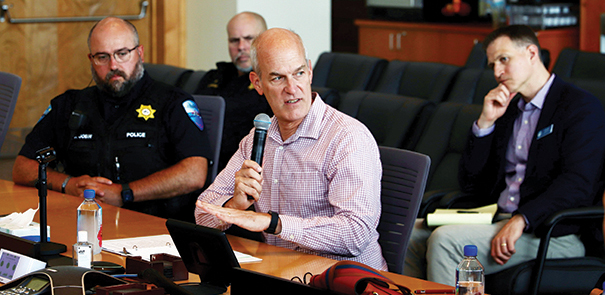
By Kalvin Valdillez, Tulalip News
By Kalvin Valdillez, Tulalip News
On the afternoon of August 6, Representative Rick Larsen (WA-02) visited with the Tulalip Board of Directors, the Tulalip Police Department, and members of the Tribe’s Treaty Rights Office and legal team to discuss a bill recently introduced to congress this month.
The bill is officially titled the Protection for Reservation Occupants Against Trafficking and Evasive Communication Act, or the Protect Act for short. If passed, this could have a major impact for tribal nations as they continue to combat the opioid and fentanyl crisis.
Tulalip Chairwoman Teri Gobin opened the gathering and shared, “First of all I want to welcome you to Tulalip and thank you for leading and introducing this bill. It’s amazing what this could do for us, the Protect Act of 2024. We’ve had 71 fentanyl overdose deaths that accounted to an actual overdose, but we’ve had a lot more deaths than that (due to addiction). The sad thing about it is the children. So many of the children are being left orphaned, both of their parents passing away from overdose. We’re having a lot of children who are born addicted, born with it in their system. So, our hands go up to you, we’re really excited about moving this forward. It’s time.”
The Protect Act addresses a glaring jurisdictional issue that currently prevents tribes from prosecuting non-tribal members for illiegal drug activities on the reservation. The act is specific to drug trafficking, but it is key to battling the crisis and preventing loss of life on reservations throughout the country and a big step for tribal court systems.
Providing a little historical context, Vice-Chair Misty Napeahi explained, “The Oliphant v. Suquamish Indian Tribe was passed by the United States Supreme Court in 1978, which literally took away the ability for tribes to prosecute non-tribal people on the reservation, and that is steeped very much in racism. I feel really thankful for you and the other congress people that are going to sign on to this bill for standing up for tribes. The people that bring the drugs in, they’re not dumb. They understand jurisdictional issues and they fully capitalize on it.”
BOD Glen Gobin added, “Across this nation there’s a fentanyl epidemic that every state is dealing with and are feeling the impact. For tribes, it’s even more difficult because of the jurisdictional questions that come up, who has criminal authority over non-Indians on the reservation. This bill looks to address that and bring safety to our community to deal with this. We’re looking to protect all of our citizens on the reservation and stand up and be part of this, fight against this epidemic that we’re all dealing with.”
In Larsen’s official press release, he surmises the Protect Act, and it reads as follows:
Specifically, the PROTECT Act:
- Provides parity for Tribal courts to issue search warrants for certain electronic communications, including social media, by adding Tribal courts to the list of courts with “competent jurisdiction” under the Stored Communications Act.
- Expands Special Tribal Criminal Jurisdiction (STCJ) to crimes associated with drug trafficking.
Amends the Bureau of Prison’s (BOP) Tribal Prisoner Program (TPP) by expanding eligibility to offenders who commit drug-trafficking-related offenses.
According to the Snohomish County Opioid Overdose and Prevention Data and Dashboard, there were 188 overdose deaths in our county alone last year. There have been numerous studies from the likes of the CDC and Washington Post that show Native communities have been hit the hardest by the opioid crisis.
The Washington State Department of Health’s Opioid and Drug Use Data Dashboard gives detailed and up-to-date statistics about the epidemic in real time. If you navigate their website and pull up overdose deaths stats based on demographics, the results are shocking. For all other races and ethnicities, there was an average of about 30 deaths per 100,000 people in 2022. The number for Alaskan Natives/American Indians was literally off the charts, with over 120 deaths per 100,000 population.
Director of Treaty Rights Office, Ryan Miller, expressed, “I’m very excited to continue to push this forward and add this as another tool in our ability to fight this problem on our reservation; for the surrounding communities as well. Yeah, we’re focused on the Tribe, we’re focused on the reservation, but this affects everybody, all of the communities around us. We’ve got so many tools that we’ve been successful with, the Healing Lodge and so many other things that have helped us bring our members out of addiction and back in the community. And those have been fantastic, but without that tool to be able to put away the people who bring these drugs on the reservation and commit these crimes against our community members, we’re not going to be successful. This is a huge step towards that.”
You can follow the bill as it goes through the process of becoming a law, as well as read it’s official text, by visiting https://www.congress.gov/bill/118th-congress/house-bill/9310?s=1&r=1.
Said Representative Larsen, “I look forward to working with you all to get the Protect Act passed and signed into law to ensure that tribes have the tools to combat the opioid epidemic and save lives. I raise my hand to all of you for the important work that you’re doing to save lives and make your communities safer.”
Charles Joseph Howard

1963-2024
Charles Joseph Howard (Charlie) was born in Tacoma, Washington on November 15, 1963 and passed away peacefully in Puyallup, Washington on August 4, 2024. Charlie was proud to be a Tulalip Tribal Member, he was born to Leona Paul-Howard. Charlie was an amazing machinist for 36 years. He traveled extensively, loved the outdoors, played golf with family and friends, enjoyed concerts, camped at pretty much every camping area in the state. Charlie loved adventure and loved most of all sharing those adventures with his Son Eric.
Charlie is survived by his one and only son Eric Paul Howard, his sister Sharon DeFevers, nieces Lesley Cortez and Lindsay Howard, nephews Jamie DeFevers and William Howard, as well as several great nieces and nephews, cousins and a great many friends who loved him.
A celebration of his life will be held Monday, August 12, 2024 at 10 AM at the Tulalip Gathering Hall.
August 10, 2024 syəcəb
Use the following link to download the August 10, 2024 issue of the syəcəb
Strengthening community ties at National Night Out

By Wade Sheldon, Tulalip News
The annual National Night Out (NNO) brought together community members at the Tulalip Amphitheater on Tuesday, August 6, fostering a deeper connection between the Tulalip Police Department (TPD) and the people of Tulalip. Several families attended to support TPD while also getting some cool swag.
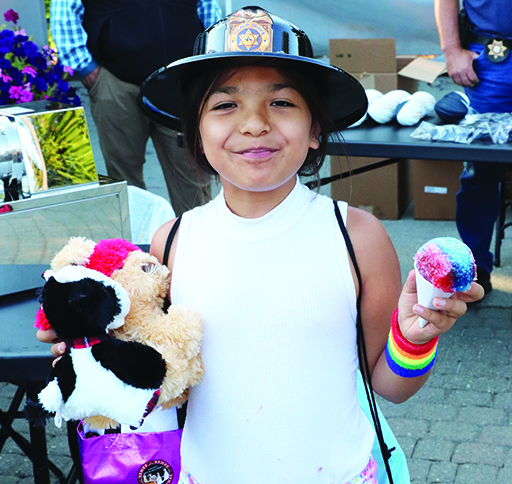
NNO strives to educate the community about various police and community programs that are accessible to them. These programs include child support, mental health and wellness, educational services and more. Each tribal department spotlighting these services had a booth where kids and adults received gifts, and could participate in games like spinning the wheel for prizes, or making buttons and keychains.
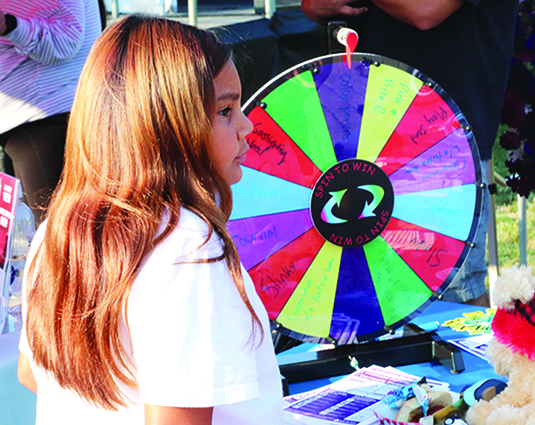
Moving along with the theme of the evening, the new Chief of Police, Shawn Ledford, was on the scene to introduce himself and express his excitement about joining the community. He shared his eagerness to engage with residents, saying, “I can’t wait to sit down, have some coffee, and go over your concerns and how the police department can meet the needs of this community.”
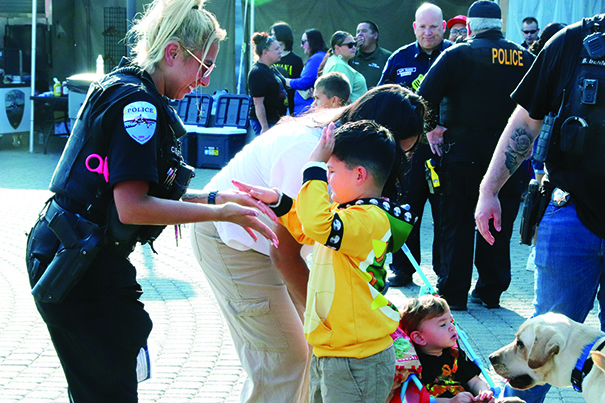
Ledford highlighted the importance of NNO, stating, “It’s a good opportunity for the community members to come out, meet some of the officers, and see some of the equipment. Break that barrier down where maybe the officer seems intimidating at some point, or it’s hard for them to make connections when they are out patrolling. Here, they can spend time with the officers and the K-9 and get to know each other.”
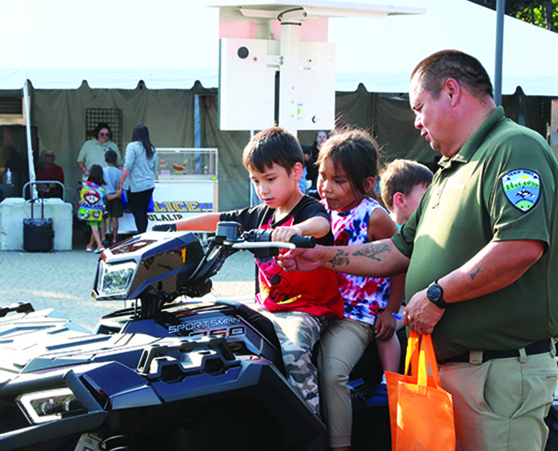
He also outlined his plans as the new Chief, emphasizing his commitment to safety: “Coming to Tulalip, I’m going to make sure that this is a safe community, making sure that we address the drug problem; help the users and hold the dealers responsible. We want to address any gang issue right away; make sure it’s not tolerated here on the reservation. Keep the neighborhoods safe. We want people to be able to walk around their community and not be worried about being a victim of crime.”
The event strengthened the bond between the Tulalip community and its police department, laying the groundwork for a safer and more connected future.
New apartment complex coming to Tulalip
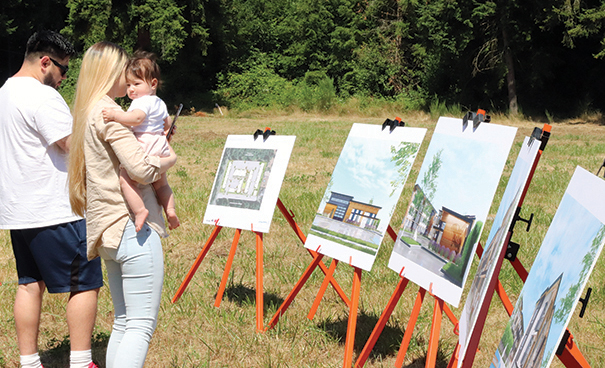
By Wade Sheldon, Tulalip News
With their ever-growing community in mind, the Tulalip Tribes hosted a groundbreaking ceremony on August 5 for their new 85-unit apartment building, Quil Creek Crossing. Located just off 27th Avenue on Sandra Madison Loop Road, the groundbreaking marks the beginning of a new chapter in the Tribes’ history.
Following a blessing of the land by tribal members Clarissa Johnny and Andy James, community members gathered to witness Tribal leaders, and representatives from the Wenaha Group and Korsmo Construction, as each of their golden shovels struck the earth.
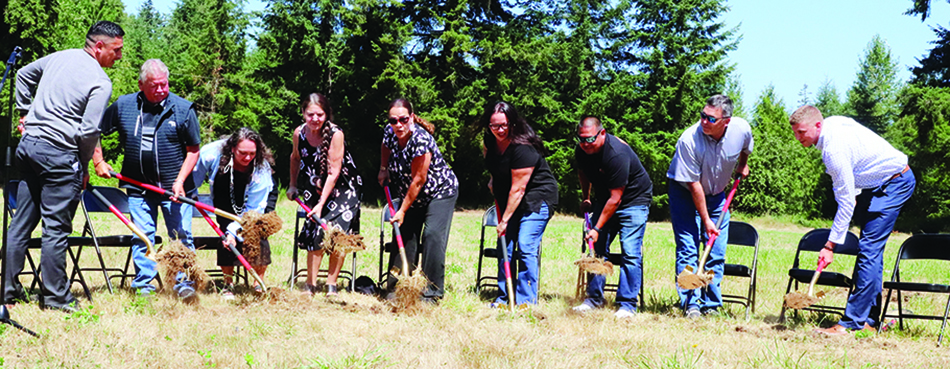
Chairwoman Teri Gobin spoke about how the property was once filled with tires and junk vehicles and how glad she is that Tulalip could turn it into housing for tribal members. She emphasized that taking the land back was extremely important, but what’s more critical is providing affordable living spaces for Tribal members.
Vice Chairwoman Misty Napeahi shared, “We started this project pre-COVID, and we wanted to build a community for our 19-25-year-olds. There are 648 young adults in that age group. So, we thought about building a community for them. What would they want? We have one, two, and three-bedroom apartments. We know some of our people already have children, so we wanted to build for their families. It will be a beautiful complex with a basketball court, a BBQ pit, and walking trails. We are trying to build a healthy community for our young people. Also, they will have an opportunity to get residency so that in the future, if they do want children, they will be eligible for enrollment.”
The new apartment building is being created with an emphasis on comfort, while also acknowledging that it can be loud when many families are in one place. Secretary Theresa Sheldon discussed the challenges of growing up in low-income housing with holes in her floors and how so many of us accept these problems as normal. She went on to discuss the available amenities that will be offered in the apartments. There will be modern appliances, stylish cabinets, and quality rugs. Additionally, she mentioned using soundproof materials for the walls and floors to ensure privacy.

“The site was designed with families in mind,” said Jason Crain, senior project manager for the Wenaha Group. “Most apartment complexes avoid having 3-bedroom units, and this apartment complex has several. It was intentional by the Tribes to promote a family environment, create a home, and raise your kids. The site has a bunch of amenities to support that. There is a large playground and a garden area. There are some playscape areas that are going to have some culturally significant artwork in the native language. The aesthetic of the building is designed to reflect the Tribe’s heritage and its relationship with cedar. It’s not cedar but designed to look like cedar.”
Crain commended COO Sam Davis and his team for helping the tribe focus on family and community and emphasizing the importance of supporting the Tribe’s growth and future. And with rental costs at an all-time high, building these apartments couldn’t come at a better time.
Council Member Glen Gobin discussed the Tribe’s longstanding goal of constructing more homes and apartments, but that they often lacked the necessary infrastructure. With the availability of sewer and electrical services and adequate space, bringing in an apartment complex as big as this will help immensely. Gobin said, “It’s also a change in how we build homes and places for our young people and elders. We have other apartments, but none like these. These are meant to be homesites for people to come in and live for as long as they need. We hope it’s transitional, but if they end up being there for 20-30 years, then that’s where they are.”
Construction on Quil Creek Crossing will begin soon, and the complex is slated for completion in 2026.
Love=Love: Tulalip Celebrates LGBTQ2S+ Community
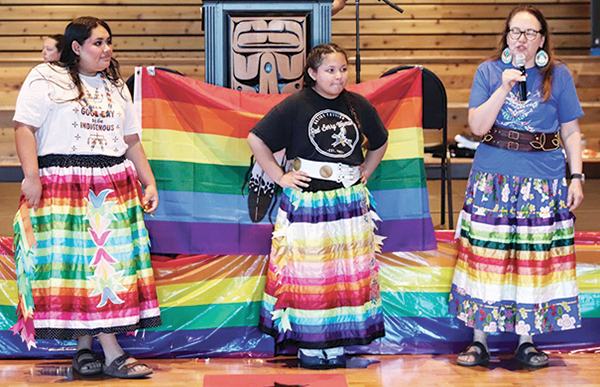
By Kalvin Valdillez, Tulalip News
Tulalip’s annual LGBTQ+ celebration experienced quite the glow up this year, moving from the small concession area of the ball fields to the spacious Gathering Hall. New location, same good times, with the addition of more activities and more room for event goers to get their groove on.
The vibrant colors of the rainbow flag and the transgender flags served as official colors of the celebration and decorated the entire Hall on the afternoon of August 4, including in a variety of balloon arrangements and dessert displays. Everywhere you looked, people were smiling ear to ear and laughing whole heartedly amongst friends and family. The major inspiration behind this gathering was to create a fun environment where tribal and community members, who identify as LGBTQ+ or 2-spirit, could build community and celebrate their lifestyle in a safe space.
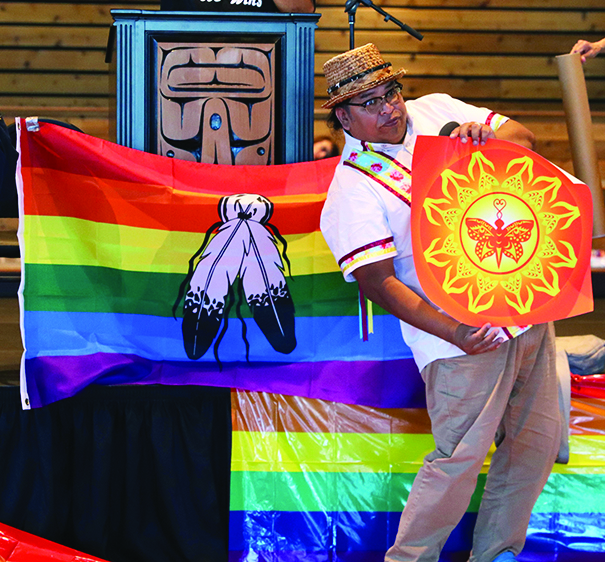
From the get-go, the pride event has been a smash hit in the community and has seen both great attendance and participation. During the planning phase of the first pride celebration in 2020, event organizer and Tulalip community member, Phoenix Two Spirit (Cree), shared, “It is so very important for the 2-spirit community to be included in all of Indian Country, in all the councils, education, youth, advisory committees – It’s part of the decolonization process, recognizing that 2-spirit people have been in the Indigenous community since time immemorial. And it’s time to recognize that there is a place for 2-spirit people in the tribal community, that they hold a special place. This is not new. This is reclaiming our past.”
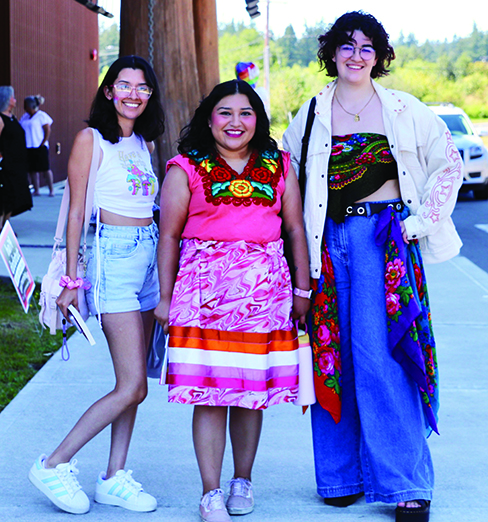
The gathering is sponsored and organized by the Problem Gambling Program. Coordinator Sarah Sense Wilson assured they are just getting started, and there’s still much work to be done in embracing and showing support to our local LGBTQ+ community.
Said Sarah, “I would love to bring in even more people and have more visibility to honoring, and respecting, and holding up our 2-spirit relatives. I know in different pockets of the community that there is still a non-acceptance. Even though there’s this idea that we’re a community of inclusiveness, we know that we’re not there yet. And I don’t mean just Tulalip, I mean nationwide. And so, anything that we can do to keep moving the needle forward and marching forward and celebrating and honoring and including everybody, the healthier our communities are overall. That’s my hope. It would be wonderful to have more Tribal leaders participate as well. I wish we had more Coast Salish drumming and singing, an opening prayer in Lushootseed, and just those kinds of elements.”
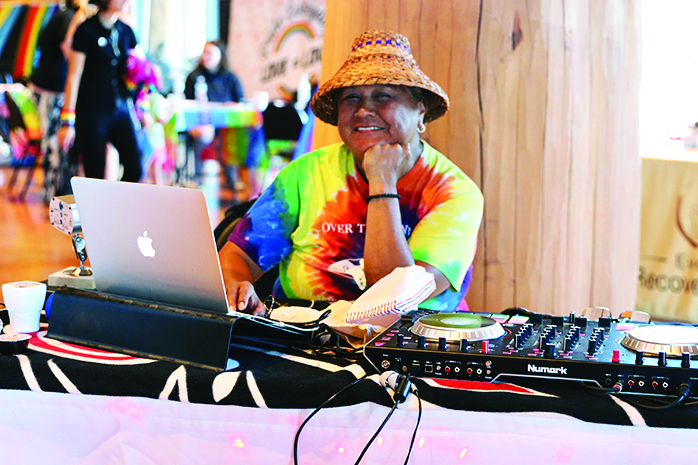
Aptly dubbed ‘Pride Everyday’, this particular celebration also includes a healthy dose of culture. Indigenous pride was on full display as attendees participated in events such as the popular fashion contest, which categories include best ribbon skirt, best ribbon shirt, and best earrings. And of course, there ain’t no party like a DJ Monie party, who returned this year and provided all the classic summertime jams throughout the afternoon. Also returning for the third consecutive year was MC Randy Vendiola and Grand Marshal Sage Vendiola, who ensured everything went smoothly and according to schedule, with both good humor and grace.
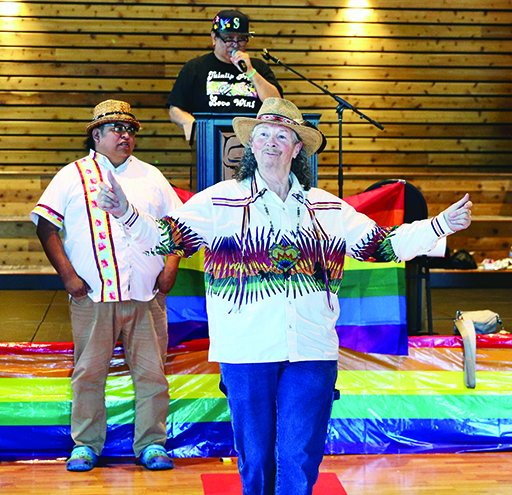
With the additional space, Sarah called in a few programs to host resource booths. Event goers could learn about the services that programs like beda?chelh, the Legacy of Healing, and the Healing to Wellness Court offer, all while obtaining free swag, playing games, creating arts and crafts, getting temporary tattoos, and building sage bundles.
Indigenous author Sasha LaPointe (Upper Skagit/Nooksack), who wrote Red Paint: The Ancestral Autobiography of a Coast Salish Punk, was the guest of honor at this year’s event. Sasha held a live reading of her book, as well as a signing, and everyone in attendance received a free copy of her work.


The five-hour event concluded with a dance party that has now officially become a yearly tradition. Everyone joins together to leave it all on the dance floor, getting down to jams like the Cha Cha Slide, the Macarena, and We Are Family.
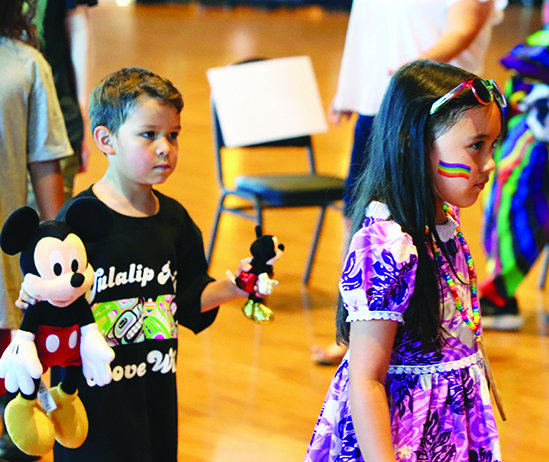
Following the gathering, DJ Monie shared a parting message, “Thank you for all the folks who showed up today to represent. It means a lot to our community to be heard, seen, acknowledged, and included. Keep up the good work in including all of us, because at the end of the day, there’s no difference in sexual orientation when you take your last breath. Love one another. Be more compassionate of the people who are around because you never know who is listening. One of my friends’ kid was using the word gay as a slander. If I didn’t correct him, he wouldn’t know better. If you see someone using words like gay in a demeaning way, correct them, because it only perpetuates separation if we continue to allow it.”
Embracing wellbriety for healing and empowerment
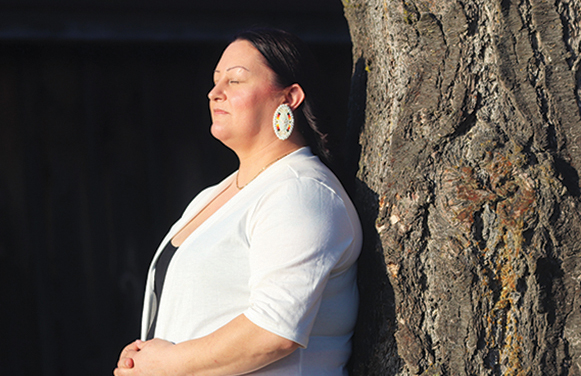
By Micheal Rios, Tulalip News
There’s been a surge of Native American communities across the country embracing the concept of wellbriety. In its purest form, wellbriety is a culture-centered movement that goes beyond sobriety to include holistic healing, cultural reconnection, and community empowerment. Rooted in tradition, wellbriety offers a culturally resonant approach to recovery, addressing not just substance use but the deep-seeded historical trauma that often underlies addiction.
Back in the summer of 2023, Tulalip’s Family Services and Problem Gambling program partnered up to bring the wellbriety movement back to Tulalip. After an exclusive training called the Medicine Wheel and the 12 steps, created by Native American nonprofit White Bison, the wellbriety movement was officially relaunched within our reservation.
“Hopefully [the concept of wellbriety] helps bring a better understanding because it talks a lot about intergenerational trauma,” explained licensed chemical dependency counselor, Robin Johnson. “So, with a better understanding of that and also their own family dynamics, this gives them an understanding of where it started, why it’s happened within their families, and why it continues to happen.”
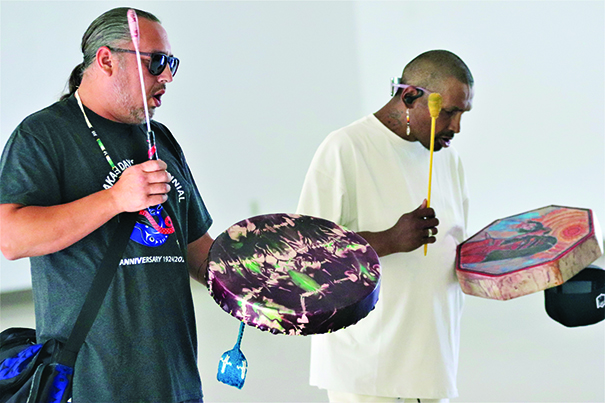
By providing that must-needed understanding that lays at the root of the cause, wellbriety aims to arm adults with the power and cultural know how to take back control of their lives. They are first taught how, then empowered to re-chart their lives with healthy choices and healthy behaviors.
“What sets [wellbriety] apart is the medicine wheel. You do the steps in a circle,” Robin further explained. “In the linear way, when you relapse you start over. In A.A. or N.A., you start over. But with the medicine wheel, it’s a continuous circle, so you continue moving forward. That makes a huge difference.”
Continuing to move forward could’ve been the theme behind the most recent wellbriety celebration hosted at the Kenny Moses Building on August 2. An estimated 80 individuals came together to create an atmosphere of strength and support for their peers who are actively working towards wellbriety for the first time, tenth time, or wherever they may be within circle.
One of the defining features of wellbriety is its emphasis on community and family support. Programs often involve not just the individual in recovery but also their family and community members. This collective approach creates a sense of shared responsibility and support, which is essential for sustained recovery and well-being. With that in mind, the most recent wellbriety celebration began in traditional communal fashion. First with a healing song offered up by Andrew Williams, followed by Helen Gobin-Henson prayer.
“These events, whether sobriety-based or wellbriety-based, are so beautiful because they continue to bring those who are in recovery together. They are giving the families an opportunity to celebrate the changes they’ve made to their lives and all their accomplishments they’ve made along the way,” acknowledged Helen. She’s been a sponsor to so many over the years its impossible for her to even guess a number, but one number she does know exactly is the number of years she has clean and sober – a whopping 36 years.
“We gather to celebrate every day these young people have chosen the red road and to be in recovery. We gather to show them support and serve as the reminder they may need that they are not alone in this journey, no matter how difficult it might seem, they are not alone. Because we can do together what we can never do alone,” added the Tulalip matriarch.
The ultimate goal of wellbriety is to restore harmony within families and communities. This is achieved through activities that promote collective healing and the strengthening of supportive relationships. By focusing on the well-being of the community as a whole, wellbriety creates an environment where individuals are more likely to succeed in their recovery journeys.
On this particular evening, five inspirational individuals, all of whom are well on their way to wellbriety, took to the middle of the Kenny Moses Building floor one by one. Each offered up their stories of struggle, hitting rock bottom, and recounting the resources they implemented to find their way back.
Desiree Dumont (42)
“In the beginning, the hardest part of my recovery was accountability because it was never my fault. It was always someone else’s fault. It took a lot of acceptance, a lot of encouragement from my community, and many long looks at the person in the mirror. An ankle monitor didn’t stop me from using. Jail didn’t stop me from using. It wasn’t until I saw how hurt and unhappy my kids were; the moment I recognized that I was the cause of their pain and in that moment, I couldn’t blame anyone else but me. I got clean for them, but along the way I realized how much I really wanted to change myself for the better.
I didn’t want to live the rest of my life with that anger and pain that always needed to be numbed away because if I did, then I could pass it on to my children. I stand before you all now a different person than I was 18-months ago. My consistency to be clean and sober is allowing me to make a better life me for me and my children. I’ve regained my license, a bank account, and, most importantly, custody of my kids. I’m a better mom and a better Desiree.”

Mitch Matta (46)
“I got clean and sober exactly 650 days ago. Like most of you, I was brought into this world watching people around me use. My father was my hero. I grew up watching him drink at least a fifth of his favorite drink R&R every day. I watched as his skin turned yellow from Jaundice. Eventually, he died of Cirrhosis of the liver in 2009. My father, my hero lost his battle to the bottle. After he died, it was easy for me to pick up that lifestyle.
I just want to stress that for me, and many others, social isolation is the trigger to use. If you know anybody who is in recovery and is in a state of isolation, then reach out to them. You have no idea how much it means to know people care. A simple phone call or text asking “how are you?” could mean the world to somebody.
After I got my year clean, my daughters moved back in with me. Their support gives me the strength to stay clean. I want to be their hero, like my dad was to me. I still have my difficult days, and when those days happen I’m thankful for my counselor Robin Johnson, the staff at the Recovery Resource Center, and the Healing Lodge. Their willingness to listen and offer encouragement is good medicine. So much so that I want to open my door to anybody and spread the word of recovery and ensure that my life revolves around being clean and sober.”
Janelle Lierman (50)
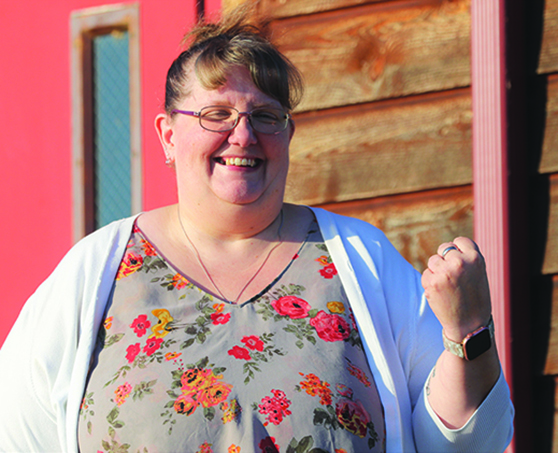
“We’re in recovery because we chose moments of fake happiness over real happiness. Fake happiness being those fleeting moments of being high, drunk, or winning at the casino. But that fake happiness is the occasional byproduct of a much larger set destructive, addictive, and life consuming behaviors that we ultimately could not control. That is why we’re in recovery.
When I was gambling, all I thought about was when I could get back to the casino again and where I could get more money from. I often gambled away my entire pay check, every week. I lied to everyone to cover up where I was and what I was doing. But at some point, each of us has decided that we had enough. Whether it was an intervention by those who love us, a criminal offense, or a near death experience, something made each of us realize we had a problem and needed to do something about it. For me, it was getting fired from my job and having to come clean to my husband.
I attend 5 to 6 recovery-based events every week because that’s what works for me. I’m very proud to say that I’ve been sober for over 15-months. The road has been anything but easy, and it’s a road that I will travel the rest of my life. I’ve learned that loving myself and forgiving myself is the first and most important step to finding healing and forgiveness in the relationships that I damaged with my addiction. I didn’t become a compulsive gambler overnight. I spent nearly 15 years and hundreds of thousands of dollars feeding my addiction. It would be unrealistic to think recovery would take any less dedication. Now, honesty, open-mindedness and accountability are the key words of my recovery.
Verle Smith (58)
“At the beginning it was a struggle. I didn’t know which way to go. I had to give it to my higher power, listen up and work on myself. It slowly got brighter. There have been struggles, I’ve relapsed multiple times, but I continue to brighten up and just punch forward.
My daughter is here with me today. You have no idea what this means to me. I now have the opportunity to be around family and to really find a sense of inner peace on the water. I love it. I still struggle today, but every morning I have the opportunity for another day, so I’m living it one day at time.
If it wasn’t for the Wellness Court, I don’t know where I’d be, if I’d even still be here. They gave me the opportunity to experience something that works for my life and I’m grateful for it. I do my mediation prayer and I believe that’s the key, make sure you say your morning prayers. I talk to a lot of people every day, like my best friend. Him and my family are my inspiration to fight harder for other people who need it. I love that people still have my back after everything.”
Christopher Solomon, (49)
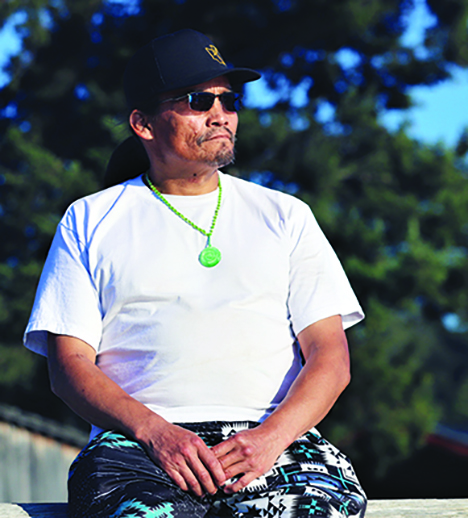
“I’ve been in and out of treatment since I was 15-years-old. When I was growing up, I thought drinking and using drugs was normal. I remember watching my mom put alcohol in my siblings’ bottles and thinking ‘if she is doing that to them, then she did that to me.’ They’d have these huge parties at their house or my aunt’s house. There would always be a big stack of beer and it would all be gone by the end of the party
Drinking was so normal for me my entire life. Getting drunk, then sobering up just to get drunk again. I’m trying to make being sober normal now. My clean date is 12-26-23.”
The impact of wellbriety on our community is profound as evidenced by the truth to power spoken by Desiree, Mitch, Janelle, Verle and Christopher. Through the dedicated staff of Family Services, Problem Gambling, and the Recovery Resource Center, a culturally relevant and empowering path to recovery is now more accessible than ever before. Through wellbriety, individuals struggling with addiction can find a renewed sense of purpose, cultural connection, and hope for the future.
Concluding, the wellbriety celebration was a countdown of days sober. Collectively, there was nearly 340 years of sobriety within the Kenny Moses Building’s walls. The next wellness celebration is tentatively scheduled for Thursday, October 24. Be on the look out for a syəcəb flyer with official time, date, and location later this fall.